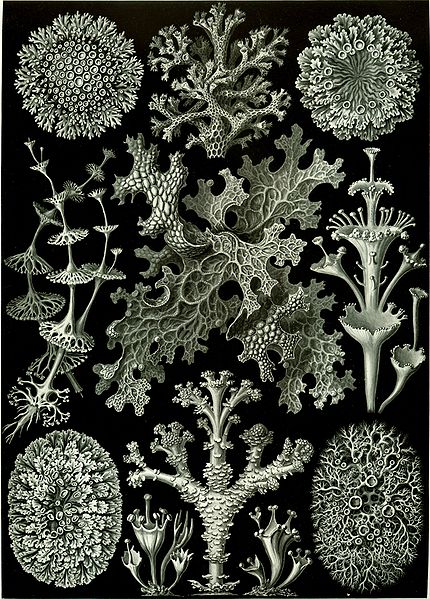 Look for Lichens - November 4, 2009 Jeff Schalau, Associate Agent, Agriculture & Natural Resources University of Arizona Cooperative Extension, Yavapai County Lichens (pronounced “likens”) are living organisms often seen growing on rock surfaces, bare soil, tree trunks and limbs, fence posts, and other living and nonliving objects. They can have a variety of colors, patterns, and growth forms and scientists continue to make unique and fascinating discoveries about lichens. Enquiring gardeners often ask if the lichens are negatively impacting the plants they grow on. Here, the answer is unequivocally “no problem”. The lichens are simply using available space to make a living without causing harm to the living plants they colonize. As many readers may remember from biology class, while lichens outwardly appear to be a single organism, but at the cellular level, they are a symbiotic relationship between a fungus and a green and/or blue-green alga (cyanobacterium). Both partners contribute to the growth of the lichen. The alga/blue-green alga conduct photosynthesis, like other plants, to produce food while the fungus supplies water and essential minerals and creates a structure that protects the alga from extreme environmental conditions. Together they thrive in some of the harshest environments on earth where neither the fungus nor alga could survive without the other. Our current knowledge tells us that over 17,000 species of fungi form lichens in partnership with a few hundred species of algae or cyanobacteria. Lichens are firmly attached to the hard surfaces they colonize. On rocks and soil, they are found in full to partial sun. On living plants, they are most numerous on limbs and trunks of large mature trees and shrubs in full sun, particularly those plants with badly thinned canopies. Most lichens will not thrive on heavily shaded twigs and branches of healthy woody plants. Few lichens are found in areas with high levels of ozone, sulfur dioxide, acid rain, and other common air pollutants; consequently, lichens are also an indicator of superior air quality. Three types of lichens have been described: crustose lichens, which are flattened against their substrate; foliose lichens, which produce leaf-like folds that extend above the substrate; and fruiticose lichens, which produce highly branched structures with hair or fingerlike projections. The color of lichens can vary from gray-green to yellow and orange to dark brown. When wet, most lichens are firm, but some black or brown forms can be gelatinous. Many lichens can reproduce asexually (i.e. cloning) when a small fragment dries, breaks off, and is transported by wind. Other lichens form small structures (diaspores) which contain both algal and fungal cells that can be transported similarly. When the fragment or diaspore comes to rest on a suitable substrate, it can then resume growth when moist conditions are present. Some lichen fungi also reproduce sexually in a manner typical of fungi, producing spores that are presumably the result of sexual fusion and meiosis. Following dispersal, such fungal spores must meet with a compatible algal partner before a functional lichen can form. As you might begin to appreciate, there is much we seem to understand about lichens and probably even more yet to be discovered. Researchers have recently discovered other fungi lurking inside the body of lichens. The function of these fungal lurkers is not yet clear, but researchers are busily sequencing the DNA of these fungi to help determine the possible relationships that exist between differing fungi within lichens. Other research is focused on isolating the fungus from the alga and/or blue-green alga. Here, the alga and cynobacterium are relatively easy to grow in the isolation of sterile culture. However, growing the fungi in isolation of its photosynthetic partners is much more challenging. Once they obtain pure cultures of each component, they reintroduce the pairs to observe how the symbiotic relationship develops under laboratory conditions. Another research project has the fungus and the alga on opposite sides of a membrane so they could sense each other but not touch and measuring changes in gene expression. New discoveries in science are more often making us reassess the basic assumptions that our current science is based upon. But getting back to the bigger picture, think about what one lichenologist said “Lichens are just fungi that have discovered agriculture.” The University of Arizona Cooperative Extension has publications and information on gardening and pest control. If you have other gardening questions, call the Master Gardener line in the Cottonwood office at 646-9113 ext. 14 or E-mail us at cottonwoodmg@yahoo.com and be sure to include your address and phone number. Find past Backyard Gardener columns or submit column ideas at the Backyard Gardener web site: http://cals.arizona.edu/yavapai/anr/hort/byg/. |